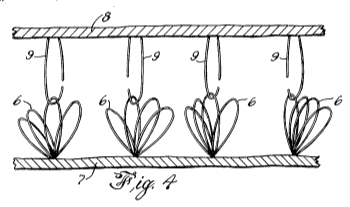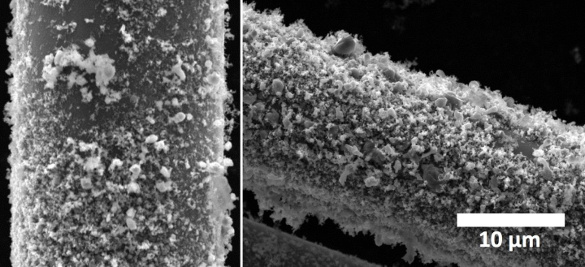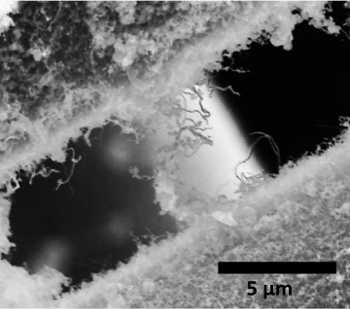Fuzzy Fibers
May 4, 2017
When our
children were
young, my wife would entertain them by reciting the following
rhyme
Fuzzy Wuzzy was a bear,
Fuzzy Wuzzy had no hair,
Fuzzy Wuzzy wasn't fuzzy,
was he?
She had heard this
venerable rhyme by some unknown
author in her own
childhood. While
fuzz is an adorable characteristic of a
teddy bear, it's generally a
household nuisance. Fuzz, however, relates to a few
technological innovations. On the lighter side, we have the simple
fuzz effect electronic circuits that
simulate a
fuzz bass guitar. In more serious electronics we have
fuzzy sets and
fuzzy logic that enable
fuzzy control systems. There are also
fuzzy extractors that convert
biometric data to
crypotographic keys.

Animal fur is designed to resist and repel water, trapping pockets of dry air near the skin to provide thermal insulation.
In the case of white polar bears and brown forest bears, it also acts as camouflage in their specific environments.
(Wikimedia Commons photograph by Jonik.)
Probably the most important
technical use of fuzz is in
Velcro® fasteners. As I wrote in a
previous article (Insect Velcro, April 22, 2013), Velcro was invented by the Swiss
electrical engineer,
George de Mestral, who noticed how well
burdock burrs, which cover the
seeds of burdock as an aid to their
dispersal, stuck to his
clothing. De Mestral examined the burrs under a
microscope and found that they were covered with
hooked spines.
De Mestral developed a
fastener based on the burdock principle, and received
patents for
Velcro®, a word formed from the French
velours (
velvet) and
crochet (hook).[2] As is typical for important inventions, expiry of the Velcro® patent in 1978 unleashed a flood of like products into the world. The original Velcro® US patent is currently cited by 210 other patents and
patent applications.[2]

Figure four of US Patent No. 3,009,235, 'Separable Fastening Device,' by George de Mestral, November 21, 1961.
(Via Google Patents.[2]
An interesting illustration of the importance of Velcro® in today's world is its reference in "
Carbon Creek," the second episode of the second season of the
television series Star Trek: Enterprise, September 25, 2002. In that episode, a
Vulcan,
stranded on
Earth and needing some quick
cash, sells the
patent rights to the Vulcan version of Velcro® (Vulcro?).
Materials scientists at
Rice University (Houston, Texas),
Hysitron Inc. (Minneapolis, Minnesota), and
NASA's Glenn Research Center have used the Velcro® principle to improve the stability of
high temperature ceramic composites for use in
rocket engines. They developed "fuzzy fibers" of
silicon carbide (SiC) that interlock together to strengthen silicon carbide
fiber-reinforced composites.[3-4]
While
nickel superalloys are presently used in high temperature
engines, ceramic materials are required for operation at higher temperatures. Ceramic is a
brittle material, so ceramic matrix composites are used in which silicon carbide fibers strengthen the materials. The fibers are first
woven and layered before
infiltration with a SiC ceramic
matrix.[3-4]
The motivation for the fuzzy fiber concept came from previous
experiments with the
growth of
carbon nanotubes on ceramic wool.[4] In the fuzzy SiC process, a silicon carbide fiber is first coated with an
iron catalyst, then a carpet of carbon nanotubes is formed on its surface using a water-assisted
chemical vapor deposition process developed in part at Rice. The carbon nanotubes are then converted into an SiC fuzz by heating in the presence of
silicon nanopowder at high temperature.[3-4] This
synthesis technique ensures a strong
bond of the SiC fuzz to the fiber.[3]

Electron micrographs of a fuzzy fiber surface. The fuzz (right) is formed by reaction of carbon nanotubes (left) with silicon, and it was found to resist heating to at least 1,000°C.[4] (Ajayan Research Group/Rice University image.)
The surface fuzz on the fibers acts as a
nanoscale version of Velcro® hooks and loops that causes contacting fibers to interlock.[4] This tight interlocking provides not only
strength, but also
resistance to environmental effects such as
oxidation.[3-4] The material should offer a longer
fatigue life and higher temperature resistance.[3] Tests showed that the
shearing force between fibers was greater with the fuzzy coating.[4]
Amelia Hart, a
research team member, explains
"Before they used silicon carbide composites, many engine parts were made of nickel superalloys that had to incorporate a cooling system, which added weight to the whole thing... By switching to ceramic matrix composites, they could take out the cooling system and go to higher temperatures. Our material will allow the creation of larger, longer-lasting turbo jet engines that go to higher temperatures than ever before."[4]
Says
Chandra Sekhar Tiwary, a Rice
postdoctoral associate who participated in this research, "The silicon carbide fiber they already use is stable to 1,600 C... So we're confident that attaching silicon carbide nanotubes and wires to add strength will make it even more cutting-edge."[4] The research team anticipates application of this technique to other materials.[4]
Funding was provided by the
Air Force Office of Scientific Research through its
Multidisciplinary University Research Initiative.[4]

Electron microscope image of silicon carbide fibers joined by surface fuzz.
(Ajayan Research Group/Rice University image.)
![]()
References:
- Margaret Andrews, "FuzzyWuzzy (quickly) Tongue Twister," YouTube Video, December 19, 2015.
- George de Mestral, "Separable Fastening Device," US Patent No. 3,009,235, November 21, 1961, (via Google Patents).
- Amelia H.C. Hart, Ryota Koizumi, John T Hamel, Peter Samora Owuor, Yusuke Ito, Sehmus Ozden, Sanjit Bhowmick, Syed Asif Syed Amanulla, Thierry Tsafack, Kunttal Keyshar, Rahul Mital, Janet Hurst, Robert Vajtai, Chandra Sekhar Tiwary, and Pulickel M Ajayan, "Velcro®-Inspired SiC Fuzzy Fibers for Aerospace Applications," ACS Appl. Mater. Interfaces, Just Accepted Manuscript (March 28, 2017), DOI: 10.1021/acsami.7b01378.
- Mike Williams, "'Fuzzy' fibers can take rockets' heat," Rice University Press Release, March 30, 2017.
Permanent Link to this article
Linked Keywords: Child; children; youth; young; nursery rhyme; venerable; author; childhood; fuzz; teddy bear; household; technology; technological; innovation; fuzz effect; electronic circuit; simulation; simulate; fuzz bass guitar; fuzzy set; fuzzy logic; fuzzy control system; fuzzy extractor; biometrics; biometric; data; crypotographic key; animal; fur; hydrophobe; resist and repel water; skin; thermal conductivity; thermal insulation; polar bear; forest; bear; camouflage; environment; Wikimedia Commons; Jonik; technical; Velcro® fastener; electrical engineering; electrical engineer; George de Mestral; arctium; burdock; bur; seed; dispersal; clothing; microscope; fish hook; hooked; spine; fastener; patent; Velcro®; velours; velvet; crochet; patent application; Google Patents; Carbon Creek; television series; Star Trek: Enterprise; Vulcan; stranded; Earth; cash; patent rights; materials scientist; Rice University (Houston, Texas); Hysitron Inc. (Minneapolis, Minnesota); NASA Glenn Research Center; high temperature; ceramic; composite material; rocket engine; silicon carbide; ceramic matrix composite; fiber-reinforced composite; nickel; superalloy; gas turbine; engine; brittleness; brittle; weaving; woven; infiltrate; infiltration; matrix; experiment; crystal growth; carbon nanotube; iron; catalysis; catalyst; chemical vapor deposition; silicon; nanoparticle; nanopowder; chemical synthesis; chemical bond; electron micrograph; chemical reaction; Celsius; °C; Ajayan Research Group Rice University; nanoscopic scale; nanoscale; strength of materials; corrosion resistance; oxide; oxidation; fatigue life; shear stress; shearing force; Amelia Hart; research; jet engine; Chandra Sekhar Tiwary; postdoctoral research; postdoctoral associate; funding; Air Force Office of Scientific Research; Multidisciplinary University Research Initiative; scanning electron microscope.